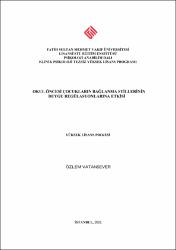| dc.contributor.advisor | Vural, Pınar | |
| dc.contributor.author | Vatansever, Özlem | |
| dc.date.accessioned | 2023-02-23T11:08:53Z | |
| dc.date.available | 2023-02-23T11:08:53Z | |
| dc.date.issued | 2021 | en_US |
| dc.identifier.citation | VATANSEVER, Özlem, Okul Öncesi Çocukların Bağlanma Stillerinin Duygu Regülasyonlarına Etkisi, Fatih Sultan Mehmet Vakıf Üniversitesi Lisansüstü Eğitim Enstitüsü Psikoloji Anabilim Dalı Klinik Psikoloji Tezsiz Yüksek Lisans Programı, Yayımlanmamış Yüksek Lisans Projesi, İstanbul 2021. | en_US |
| dc.identifier.uri | https://hdl.handle.net/11352/4308 | |
| dc.description.abstract | Yaşamın ilk evrelerinde güvenlik ve yakınlık ile ilişkili bir bağın kurulduğunu ileri süren yaklaşım bağlanma teorisidir. Bu teori üç ana bağlanma stilini ortaya koyar. Bebeğin ihtiyacına yönelik bakım verenin davranışları değişkenlik gösterdiğinde kaygılı bağlanma stili oluşur. İhtiyaca yönelik davranışlara duyarsız kalındığında ise kaçıngan bağlanma stili gerçekleşir. Bakım verenin, bebeğin ihtiyaçlarına yönelik tutarlı davranması güvenli bir bağlanma stilini meydana getirir. İhtiyaçları duyarlı bir şekilde karşılanmış çocuklar başka bir deyişle duygularını özgürce ifade eden çocuklardır. Duygularını özgürce ifade eden çocukların duygu regülasyon becerileri de gelişir. Duygu regülasyonu, yaşanılan duygunun farkında olup duygusal uyarılmanın oluşturduğu tepkiler üzerinde kontrol sağlama becerisidir. Bu çalışmanın amacı, okul öncesi çocukların (2-6 yaş) bağlanma stillerinin duygu regülasyon becerilerine etkisini ilgili literatürde yer alan kaynaklar aracılığı ile ortaya koymaktır. Bu çalışma, okul öncesi çocukların duygu regülasyon becerilerine dikkat çekmek ve bu dikkati bağlanma üzerinden açıklamak için anahtar niteliğindedir. | en_US |
| dc.description.abstract | Attachment theory is the approach asserting that a bond related to security and intimacy is established in the early stages of life. This theory identifies three main attachment styles.When the caregiver's behaviors are incompatible towards the infant's needs,anxious attachment style occurs.And if the caregiver is mostly deaf to the infant’s needs, avoidant attachment style emerges. However,caregiver's consistent behavior towards the infant's needs creates a secure attachment style.In other words,children whose needs are met sensitively are the ones who can express their feelings freely. The children expressing their emotions freely are also more skilled at emotion regulation.Emotion regulation is the ability to be aware of the emotion experienced and to have control over the reactions created by emotional arousal. The aim of this study is to reveal the effect of attachment styles of preschool children (2-6 years old) on emotion regulation skills through the sources in the relevant literature. Moreover, this study is a key to hold up to the emotion regulation skills of preschool children and to explain this through attachment theory. | en_US |
| dc.language.iso | tur | en_US |
| dc.publisher | Fatih Sultan Mehmet Vakıf Üniversitesi, Lisansüstü Eğitim Enstitüsü | en_US |
| dc.rights | info:eu-repo/semantics/openAccess | en_US |
| dc.subject | Bağlanma Teorisi | en_US |
| dc.subject | Bağlanma Stilleri | en_US |
| dc.subject | Duygular | en_US |
| dc.subject | Duygu Regülasyonu | en_US |
| dc.subject | Okul Öncesi Dönem | en_US |
| dc.subject | Attachment Theory | en_US |
| dc.subject | Attachment Styles | en_US |
| dc.subject | Emotions | en_US |
| dc.subject | Emotion Regulation | en_US |
| dc.subject | Preschool Period | en_US |
| dc.title | Okul Öncesi Çocukların Bağlanma Stillerinin Duygu Regülasyonlarına Etkisi | en_US |
| dc.title.alternative | The Effect Of Preschool Children’s Attachment Styles on Emotional Regulations | en_US |
| dc.type | other | en_US |
| dc.contributor.department | FSM Vakıf Üniversitesi, Lisansüstü Eğitim Enstitüsü, Psikoloji Ana Bilim Dalı | en_US |
| dc.relation.publicationcategory | Tez | en_US |
| dc.contributor.institutionauthor | Vatansever, Özlem | |



















